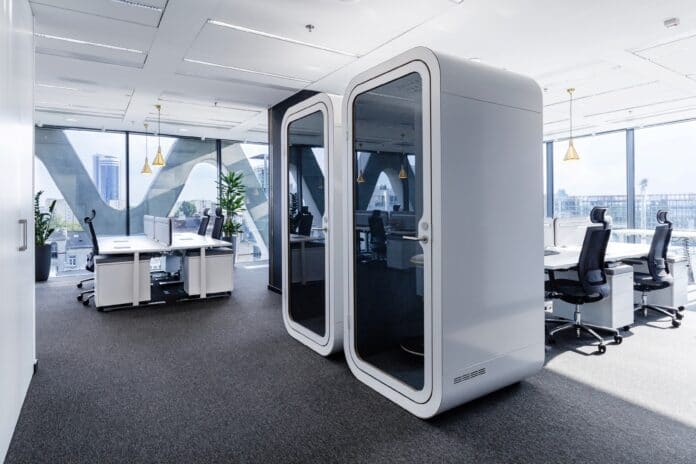
Comment by: Bartłomiej Zagrodnik, Managing Partner/CEO at Walter Herz
Do companies limit the amount of leased space to reduce costs? What is the trend on the office market?
Companies are now looking for the most optimal model of work for them, while at the same time recognizing their real need for office space. They verify the size of the offices, the functionality of their layout and the new expectations of the employees. Remote work is becoming more and more available. Changes in the aspect of demand depend on the industry. Companies whose business model is based on a process will not need as much space as creative companies and innovative entities, where work efficiency depends on interpersonal communication, interaction and exchange of ideas.
It is hard to talk about the trend yet, because some companies, mainly global corporations, have not returned to their offices. Companies study the situation, analyze the working environment to create a new and best working model, redesign offices and adapt them to the current conditions. In some cases, the results of analysis show that the currently occupied office space is even too small to meet the new health and safety requirements and ensure the safety of employees. Companies that still stay in the home office incur additional costs related to conducting new health and safety training online, providing employees with desks, chairs suitable for home office, and covering the costs of electricity and internet.
Do companies plan to keep the remote work system on a permanent basis? How will this translate into the office layout?
Virtually all tenants will now be more and more willing to allow remote work in various models and different work systems. Companies are trying to reduce the size of the office space they occupy and they will probably more often introduce a system of hot desks, that is the rotation of workstations. Offices in many companies will now serve primarily as a place for business meetings and exchange of views for the team, and this is the direction in which the design and organization of space will go.
There is also a visible trend related to the fact that business is becoming more and more open to videoconferences. Meetings with customers and contractors are now organized this way as standard, although before the virus most companies preferred to do business by organizing face-to-face meetings. Hence, now more and more mini-rooms, telephone booths and cubicles are created in office spaces, where employees can make video calls without distractions.
What factors are critical today when choosing an office?
The trend of looking for savings is clearly noticeable on the office market. Companies are increasingly using the opportunities offered by home office. On the other hand, offices become a mainstay of security, and this makes the technical and functional expectations regarding the leased space even higher.
Our recent research, which included several hundred companies, shows that employers focus primarily on safety in the office, as well as flexible and functional work solutions, such as a hot desk system. They also implement procedures related to remote work and home office, most often on a 2/5 or 3/5 weekly basis.
The key factor when choosing today is, above all, the possibility of implementing solutions that increase sanitary safety in the workspace. In addition, the aspect of the location of office properties and their accessibility by transport becomes pivotal even more than before.
What are the effects of contract renegotiation? Do tenants and landlords reach an agreement?
All market participants are actively following the developments. As usual, there are some speculators. However, I have a feeling that the market is striving for equilibrium and stabilization. Tenants try to save money when the offices are not fully used. Landlords, in exchange for discounts, expect an extension of the lease period. The various types of discussions and negotiations currently taking place find a number of common solutions in terms of reducing fees, spreading payments, extending contracts and spreading certain incentives over time.
Companies that reduce employment and try to reduce costs, in turn, try to sublet some offices, as long as the terms of the contract allow it, or the owner agrees. Some of the companies that are ending their lease contracts are now also considering more economical locations. There is also a growing interest in the hybrid rental model, combining traditional lease with instant offices.
Do tenants use co-working space to a greater extent?
It seems that tenants will use instant offices more often than co-working spaces, which give the opportunity to work in a familiar, isolated environment. It comes from the need for greater safety. Working in your own office has many advantages, it stimulates the exchange of views and creativity, from which the company gains the most.
Do companies plan to shift direct business meetings to instant messaging?
Business relationships, which until recently seemed impossible to implement remotely, are now routinely established online. Today, most of these activities are performed remotely, without meetings. This speeds up the work on different projects and is more convenient. It also allows teams dispersed in different regions of the country to work together. Today, teams use solutions that have not been seen before.
To what extent will COVID-19 affect the office market in Poland? Will rental rates drop? In what direction will the segment develop?
Domestic office markets, which previously had a shortage of vacant space, are striving for greater balance through rising vacancy rates. Tenants have an increasing amount of space to choose from. Also, the market sees greater attention to relationships.
It seems that Warsaw will be affected by the decline in demand for offices the least severely. This is evidenced by the large number of currently conducted renegotiations of short and medium-term lease agreements.
In the case of speculative projects, the commercialization process will become longer. Most construction projects are carried out on time, but the banks are clearly reinforcing their policies when it comes to financing new real estate development projects. Therefore, it is likely that in the upcoming years, after the completion of investments under construction today, the increase in supply on the office market will significantly decrease.
However, a temporary decrease in demand for space and an increase in the vacancy rate will probably not destabilize the office market in the long term. It is optimistic that large international funds are still interested in investing in office real estate in Poland. The first half of this year ended with a surprisingly good result in this respect.
Prices for leasing space on the office market will decline in the near future. Generally, however, this will not apply to asking rates, but to effective rent, which will be lowered thanks to extensive incentive packages. On the other hand, price reductions per meter are visible in older generation buildings. We are also seeing a decline in construction prices for arrangement works.
Comment by: Magdalena Zagrodnik, Business Partner at Walter Herz
What work systems are most often implemented by the companies nowadays?
In June, employees returned to offices. The most commonly used solution is to combine remote and stationary work. Some companies have completely returned to their offices, others operate on a two-shift basis to reduce the risk of contamination and prevent all employees from having to quarantine. While other companies have not returned to their offices at all and will probably not come back until the end of this year. The decisions made regarding the form of work are related to the specificity and profile of companies and the type of business.
Employers are now examining the effectiveness and effects of home office. Modern systems monitoring people’s work, verifying traffic in specific systems and the login time of employees help control work performed remotely. However, People Management is gaining even more importance. Managers who will be able to take care of employee morale online, motivate to work and help the team remain as one.
In many companies, however, the experiment related to remote work did not work. It is mainly about the human factor and the efficiency that the teamwork brings. Nevertheless, most companies today declare their willingness to partially switch to remote work and create separated teams. Communication systems and applications enabling remote communication are also implemented on a big scale.
Is remote work on a mass scale a good direction for change?
In recent months, the work system has been redefined. Until March 2020, the work-life balance formula was the key for most modern companies. According to which, work was done in the office, and at home, the focus was only on private life. The massive transition to home office has shown that we can also work from home. But at the same time, it also proved how valuable office work is in the context of integration and building relationships with other employees of the company. The social value of office work turned out to be more important than we previously thought.
Recent months have exposed many disadvantages of remote work, which should be an impulse for companies not to use such a solution on a large scale, when it will no longer be required for health reasons. People working from home have a bigger problem with identifying with the company and establishing close relationships with the team. They rotate more often, they can be easily taken over by the competition, because they are heading towards the independence of the individual, which is not conducive to work efficiency.
How does the new work style affect team performance?
In recent years, offices have been designed in a way that supports networking and integration between the employees. Large kitchens, chill out areas and meeting rooms were arranged. Resignation from this type of functionality, favoring good communication and replacing them with a home office system diminishes teams’ creativity. The team spirit and interesting ideas are born in the office, which for many companies are key to development. Therefore, decisions on the target reduction of the traditional office and switching to remote work should be supported by in-depth analysis, because it may have negative effects in the business aspect.
Do employees want to remain in the home office?
Our analysis show that the vast majority of employees in companies want to return to their offices. Research also shows that the greatest problem with remote work concerns, paradoxically, young employees who are more used to online contacts than others. It turns out, however, that home office has the most stressful effect on them. This is because to the greatest extent they need feedback on the work they do and clearly defined development opportunities, which is their primary element. In the office, however, they have the opportunity to exchange information and gain knowledge. Last but not least, working in an office community also strengthens their sense of belonging.
Some employees, in turn, value peace and quiet at home, which allows them to focus more, and this is a valuable feedback for employers in terms of trends in office design. And a hint that open space will not always be a good solution.
Our team has been dreaming of returning to the office for a long time, so we decided to come back, as all Walter Herz employees were already tired of working remotely.


















